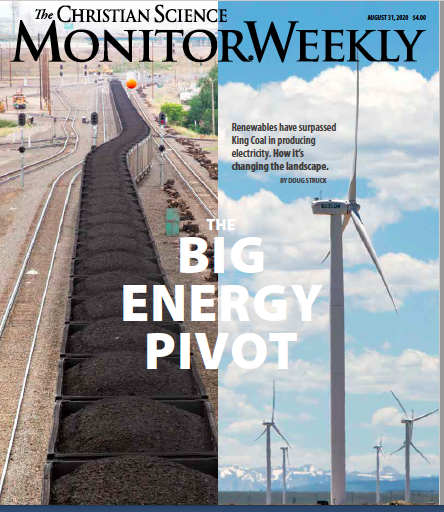SEE readable PDF of full print story
Power pivot: What happens in states where wind dethrones King Coal?
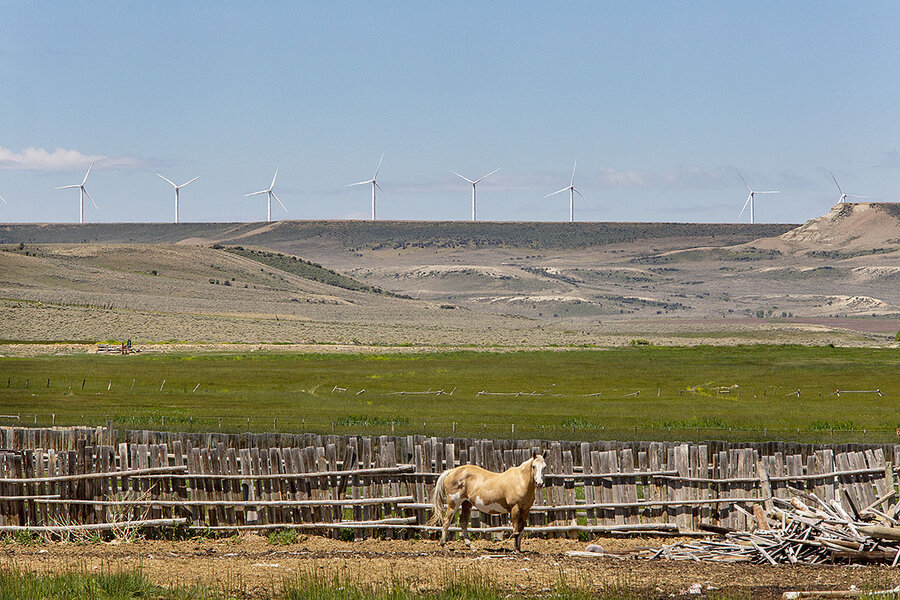
Melanie Stetson Freeman/StaffA horse stands in the foreground of another wind farm on a hilltop near Mountain View in southwestern Wyoming. America’s self-proclaimed “energy state,” Wyoming is rich in fossil fuels but is increasingly harnessing wind and solar energy to power homes.
August 21, 2020
- By Doug Struck Correspondent
MEDICINE BOW, WYO.
Laine Anderson scans the Wyoming prairie, a dusty expanse of sagebrush and prairie dogs scowling from atop their mounds. An antelope whips past the front of his truck. “They always cut in front of you,” Mr. Anderson says, shaking his head. It’s one of those mysteries.
Mr. Anderson doesn’t see this dry plateau near Medicine Bow as empty; he sees it as the future. The wide horizon is sliced vertically by slender towers. Below, workers hunch over machinery, assembling components. Giant propellers wait on the ground to be lifted atop the towers.
Before year’s end, says Mr. Anderson, the director of wind operations for the PacifiCorp utility, 132 giant wind turbines will stir from air racing down the Rocky Mountains. On a breezy day, they could power a medium-sized city.
The U.S. Energy Information Administration (EIA) says the future that Mr. Anderson envisions, in one sense, has already come. For the first time, according to the agency, U.S. renewable power will provide more electricity in 2020 than coal power, which has reigned king of the country’s electric grid for more than 70 years. What analysts see as a pivotal point in the country’s energy supply has arrived much sooner than expected.
“This is a very exciting moment,” says Sonia Aggarwal, vice president of Energy Innovation, a clean energy think tank in San Francisco. “A lot of experts were saying we will reach this point sometime, maybe 2050. They didn’t think it would be this quickly.”
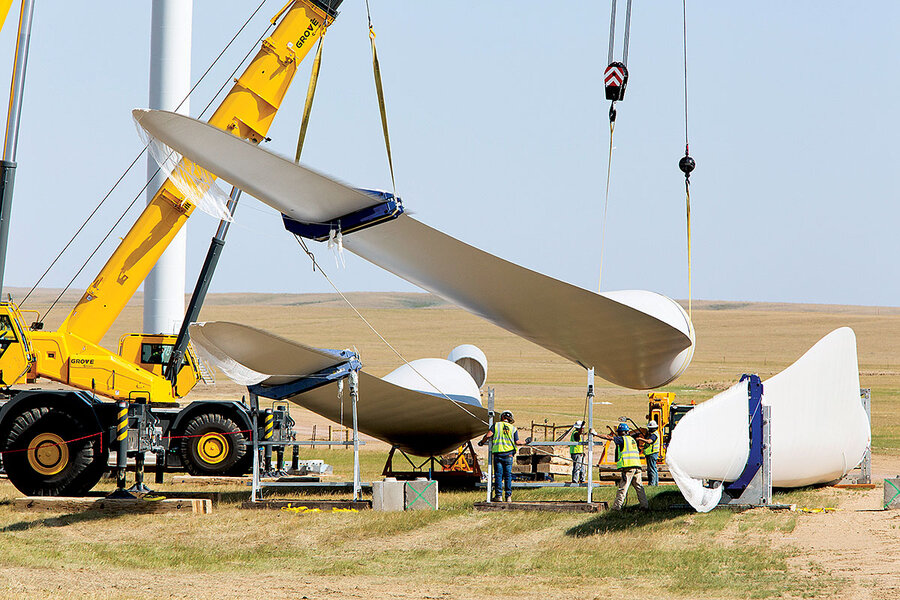
Melanie Stetson Freeman/StaffCranes hoist huge blades for wind turbines being installed outside Medicine Bow, Wyoming. The utility PacifiCorp is erecting 132 wind turbines at two locations in Carbon County.
Like most historical inflections, no single path led to this juncture. Coal did not enter a downward spiral solely because of renewables, government regulations, or cheaper natural gas. It was all of the above. Wind and solar power did not begin to expand dramatically because of a newfound ardor for the environment, the demands of climate change, or cheaper technology. It was all of the above.
The moment demonstrates an underrated force of change. What seems an immutable trajectory can bend under the weight of tens of thousands of discrete decisions – a homeowner putting a solar panel on her roof, a business buying a cleaner furnace, a town council opting for green power, a power plant converting to a cheaper fuel – which together create a new landscape.
“We’ve reached a point where it is now cheaper to build and operate a wind farm or solar plant than it is to operate a coal plant,” says Joe Daniel, senior energy analyst at the Union of Concerned Scientists in Washington. “And that trend is going to continue.”
“Built on coal”
Wyoming feels the trends acutely. More than most, it harbors prodigious amounts of both traditional energy resources and renewables – providing a window into the transition the nation is undergoing and the tensions that can accompany it. Indeed, the rise of renewables and decline of coal hold searing consequences for those across the state who toil to keep America’s lights on.
“This area was built on coal,” says Dave Freshour, who spent four decades as a welder, much of it in mines. When COVID-19 hit, he retired. Now he and his wife, Peggy, live in a mobile home between the Eagle Butte coal mine and Dry Fork coal power station north of Gillette, Wyoming, contemplating their next move.
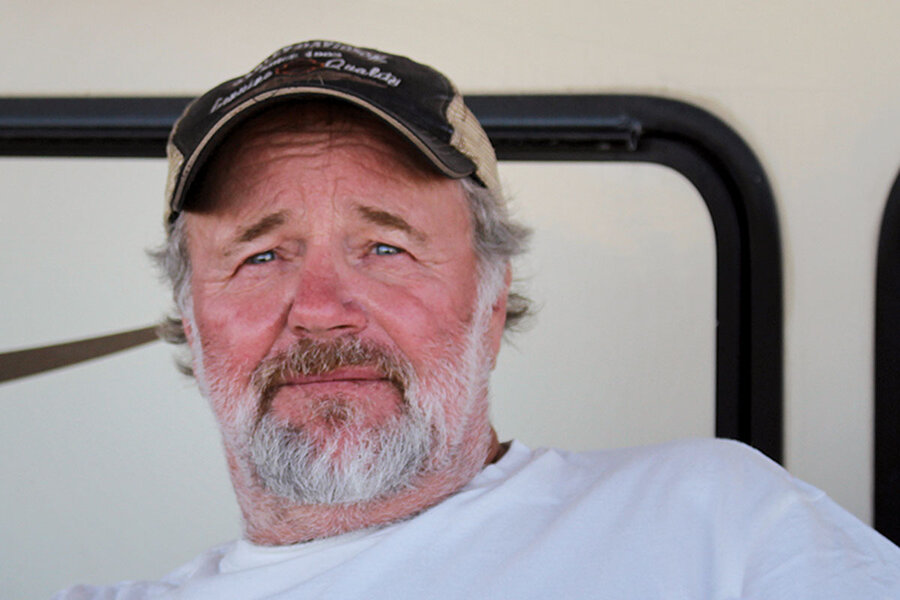
Doug Struck“Coal provided a fabulous living to me and a lot of people,” says Dave Freshour, a welder who worked for many years in Wyoming mines. “But the writing is on the wall. If you don’t see it, you’re living in a dream world.”
“Coal provided a fabulous living to me and a lot of people,” he says. “But the writing is on the wall. If you don’t see it, you’re living in a dream world.”
Wyoming bills itself as “the energy state” for good reason. It produces 40% of the coal mined in the United States, along with large quantities of oil and natural gas. In northeastern Wyoming, peat that settled 60 million years ago in primordial bogs compressed into a vast seam of coal just under the surface. It is called the Powder River Basin, and just one of its many mines – the North Antelope Rochelle – is the largest in the world, by reserves.
Mining jobs are woven into the fabric here. “Where else can you earn almost $100,000 right out of high school?” asks one coal truck driver. While miners in Appalachia plunge themselves miles into the ground to pry at meandering black seams, in Wyoming they need only scrape away the earth, dynamite the sub-bituminous quarry, and haul it away in trucks.
Gillette, logistics capital of the Powder River Basin, is built on rangeland once prowled by cowboys and citizens of the Arapaho, Crow, and Sioux. Explorer John C. Fremont and his guide Kit Carson noticed coal in the territory in 1843, and the Union Pacific Railroad started hauling coal from here even before finishing the transcontinental railway in 1869. Wyoming boomed with miners after the 1970s oil crises. Those miners now pilot the largest vehicles in the world. The open pits growl with coal-smudged trucks and excavators 24 hours a day.
Most miners work a grueling schedule of 12-hour shifts that alternate every three or four days. “When you see the paycheck, you say, ‘Wow, that’s good money,’” says Casey Cordova, who sits 27 feet high in the cab of a coal truck larger than a house. “But the biggest challenge is the shifts. How do I adjust? How do I set my body to adjust?”
By the mid-1980s, Wyoming produced the most coal in the country. Cheap and plentiful, it rumbled in train cars out of Gillette and powered electrical plants all over the U.S.
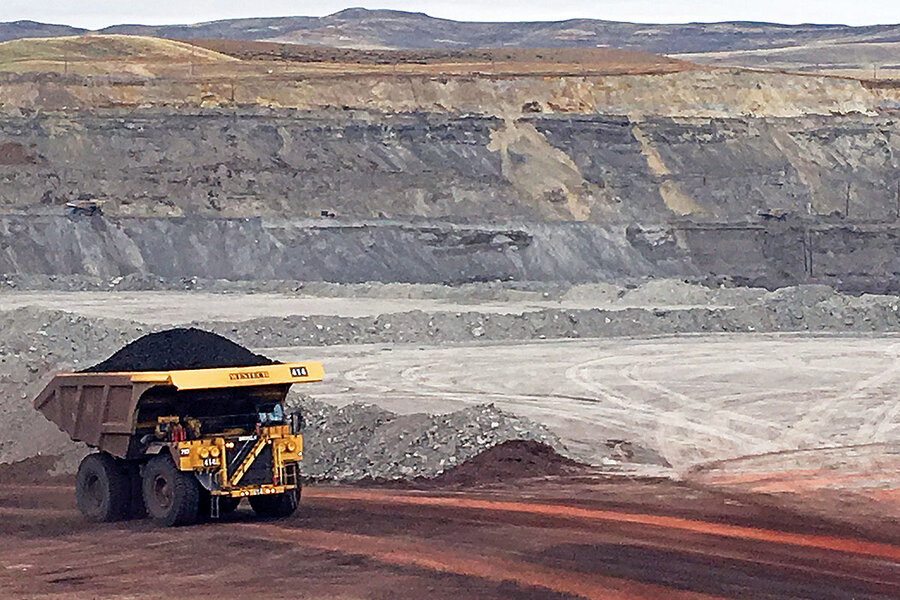
Mead Gruver/AP/FileA truck hauls coal at the Eagle Butte mine near Gillette, Wyoming. Mines in the Powder River Basin have laid off workers in recent years.
But coal is dirty: Mining scars the earth, and deep tunnel mines pollute groundwater; burning coal produces ash and toxic chemicals that create acid rain and shorten lives; and carbon dioxide is overheating the planet.
Wind and solar are clean alternatives, but for decades they were such a small portion of the nation’s electric supply they didn’t challenge King Coal. Another fossil fuel did: natural gas. When engineers figured out how to turn drills sideways and inject fluid into subterranean hideaways to force out gas, electricity plants could suddenly run on fracked natural gas that emitted only about half as much carbon dioxide.
Demand for coal began falling nationally after 2007 under the pressure of cheaper natural gas, climate concerns, and the closure of old coal power plants. At first, only Appalachian coal miners struggled: Lower rail prices made the more desirable low-sulfur coal of the West available to customers in the East. Western coal miners cannibalized the jobs of their Eastern colleagues.
But the trends finally hit Wyoming with a jolt. In 2016, four mines laid off nearly 600 workers. Last year, two mines in the Powder River Basin, Blackjewel and Cloud Peak, abruptly went bankrupt, sending home 600 workers and leaving a trail of bounced paychecks. More layoffs this year have idled another 420 miners.
“Don’t come back for your shift,” Lynne Huskinson’s supervisor told her on July 1, 2019, over the phone. “We’re all unemployed.”
Ms. Huskinson started working for the mines just out of high school in 1979 when they were looking for women to operate big machines. It gave her 38 years of steady employment – and good money. But when the Blackjewel mine went bankrupt underneath her feet last year, Ms. Huskinson began reading up. She found, she says, that the huge coal companies were trying to sell mines, getting out of the business, while assuring workers all was fine. “We were lied to,” she says.
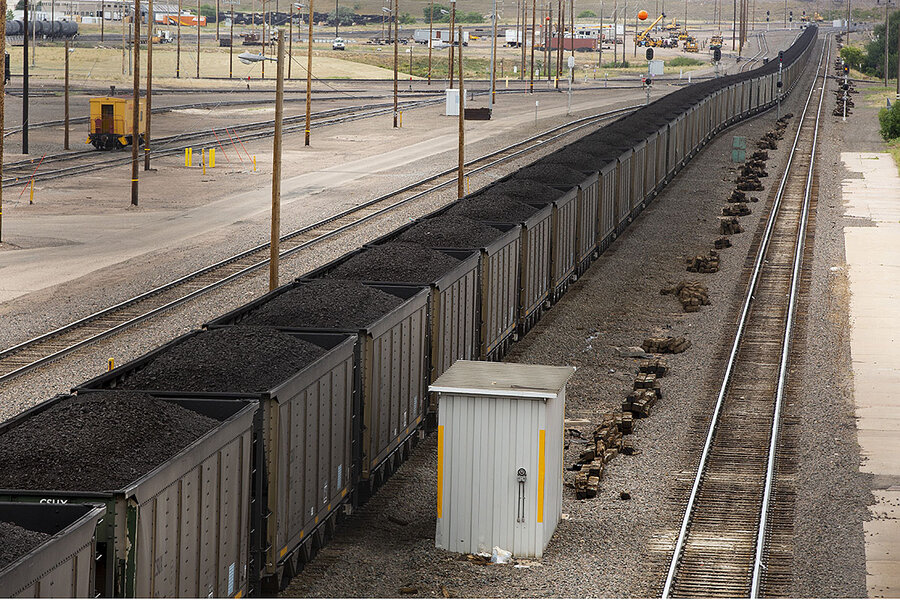
Melanie Stetson Freeman/StaffA train filled with coal stops in Cheyenne, Wyoming. Fewer trains have been rumbling through the state as coal consumption has dropped.
And she found that the inexhaustible coal that for so long had fired the economy of Wyoming and the utility boxes of America had poor prospects. “People are going to renewables – solar and wind. That’s the future,” she concludes.
The earlier 2016 layoffs were “the first time something like that had happened in more than 30 years. It was a blow,” says Gillette’s mayor, Louise Carter-King, whose father also served as mayor. “Coal was good jobs.”
Since then, the 1.5-mile-long coal trains that block traffic in Gillette have grown shorter and less frequent. The Burlington Northern Santa Fe Railway parked more than 100 locomotives outside town four years ago, and this June finally closed its big Donkey Creek switchyard there.
The city suddenly lost $60 million of its $146 million budget, and began cutting services. Many miners eventually returned to work when the mines were purchased from bankrupt Blackjewel, but layoffs have continued intermittently. Scores of businesses that supply the mines are hurting. Many workers have had to leave Gillette.
“You’ve got to go where the work is,” says the wife of a railroad worker who stayed behind in Gillette to sell the house and see their son through high school graduation before joining her husband in Colorado. “There’s just nothing else here.”
“I’ve lost seven families who were customers because they had to leave,” says Anne Fischer, who runs a small photography studio in downtown Gillette and counts on her customers’ milestones – graduations, weddings, births – for future business. She had to give up half her studio space.
It’s common to hear in Wyoming that former President Barack Obama is to blame for coal’s demise because he enforced regulations of the 1970 Clean Air Act. President Donald Trump promised he would save mines by ending what he called Mr. Obama’s “war on coal.” In fact, neither president could do little more than nudge the larger forces bearing down on the industry.
“Trump rolled back some regulations, but it doesn’t mean anyone is buying [coal] now,” shrugs Mayor Carter-King.
For a while, coal companies said exports would save the industry, but world markets are fickle and energy-hungry Asia is difficult to supply from far-away Wyoming. For working miners who are still picking up overtime shifts, it is tempting to believe they, and mining, can hang on. “We aren’t dead yet!” the mayor insists.
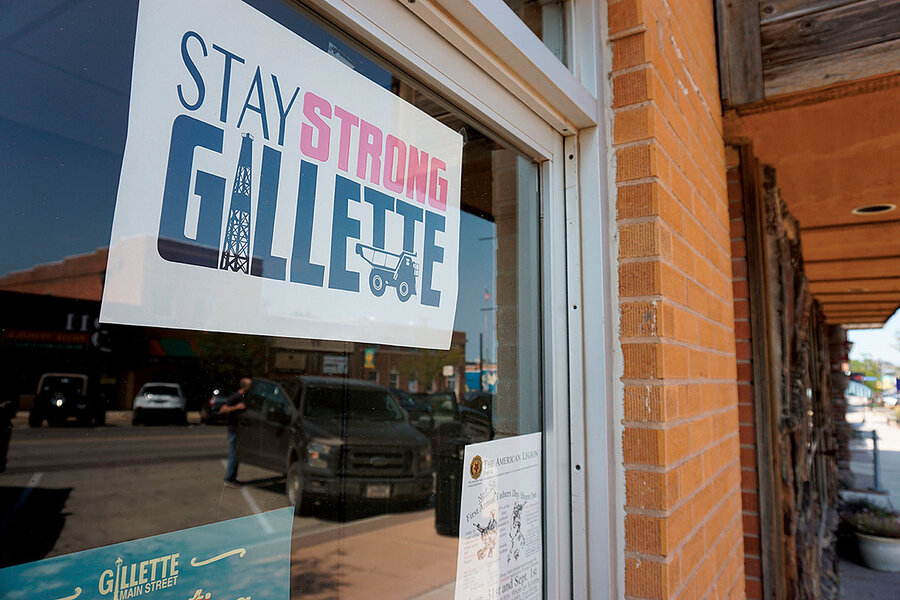
Mead Gruver/AP/FileA poster in a storefront urges locals to persevere amid hardship in Gillette, Wyoming. Coal mines in the nearby Powder River Basin have idled hundreds of workers in recent years, prompting businesses to close and the town to dramatically slash its budget.
“The time is now to start thinking of the wind-down,” says Shannon Anderson, a lawyer with the Powder River Basin Resource Council in Sheridan. “Right now in Wyoming we still are producing almost 300 million tons, employing 5,000 direct miners, and all of the ancillary jobs. We still have a dozen of the nation’s largest coal mines.” But, she says, “we are on a ticking clock.”
Coal demand fell last year to the lowest level in 45 years, and the economic slowdown because of the pandemic will make 2020 worse. “We’ve gone from [fueling] 50% of the country’s electricity to under 20% in just under a decade,” says Robert Godby, an energy expert at the University of Wyoming in Laramie. “It is just incredible.”
According to the EIA forecast in June, coal will provide 17% of the country’s electricity this year, renewables 21%, and natural gas 41%. The gas share is expected to drop next year if prices rise after the pandemic.
“We’ve always known it’s a gamble,” says Wyatt Smith, who worked in the oil fields and switched to a job in the coal fields about eight months ago. Mining is a family affair: His stepmother is his shift dispatcher. “Coal is not going to be a forever deal for me,” he says while watching his baby at his Gillette home. “It’s definitely not going to be around forever. When it does fall, a lot of people are going to be hurting.”
The pall over the coal fields is partly one of pride. Wyoming savored a patriotic image of tough workers powering a nation; now those miners resent the widespread perception that coal is “dirty.” With a Western culture of tight-lipped endurance, some just don’t want to broach the subject.
“We are not just talking about energy,” explains Dawn Hardy, whose family – husband, father, sons – worked in mines or related businesses. “We are talking about people’s way of life, the homes they have built. This is really hard. To tell someone everything you have worked for is worthless …” She trails off.
Between shifts in the mine, her husband started a craft brewery in the town’s old post office. The bar’s footrest is a length of railroad track. Drill bits are part of the decor. “We sit in church with four generations of our family” in Gillette, Ms. Hardy says softly. “This is home. It’s hard to see what we are going to be able to do to keep our population.”
She pauses, struggling as tears well up. “If my kids asked me if they should start a business here, I would say no.”
Harnessing the wind
Mr. Anderson, the wind operations director, represents the beckoning future of Wyoming’s economy. In his neat blue PacifiCorp shirt, he doesn’t look like a man who ran a dude ranch for 20 years. But he’s happy in his new job overseeing the creation of a series of wind farms that could help preserve Wyoming’s place as an electrical socket for the nation.
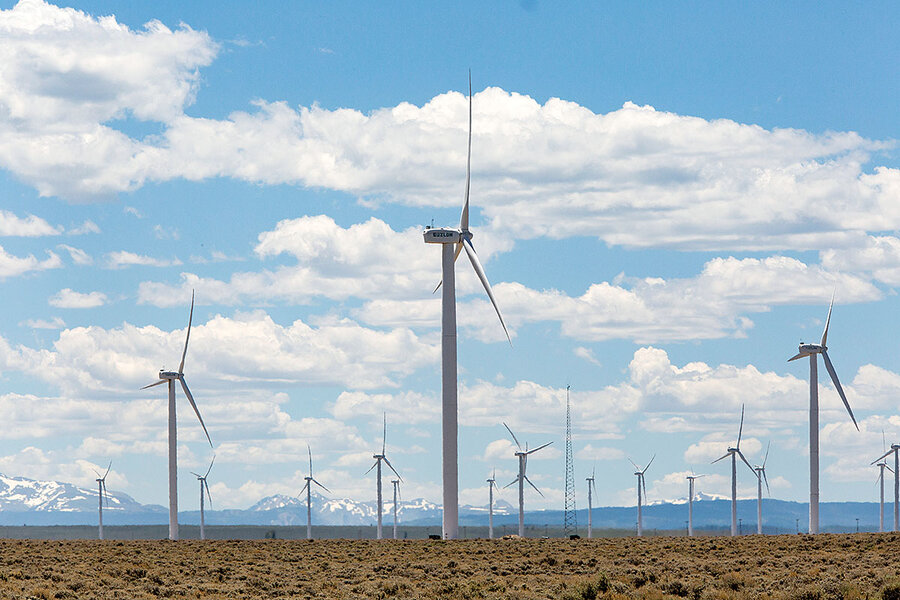
Melanie Stetson Freeman/StaffWind turbines spin in Fort Bridger, Wyoming, on July 4, 2020. The state is using alternatives to coal, including renewable sources.
“If Wyoming had the transmission lines and they would let us, I’m sure this whole area would be covered with turbines,” he says, gazing across a landscape of scrub and endless horizons.
Yet wind energy isn’t going to replace the hundreds of jobs being lost in the coal fields. Wind farms bring a spurt of employment during construction, but then need only about one technician per 10 turbines for maintenance.
The EIA forecasts an 11% growth in electricity from renewable sources this year, the largest portion of new capacity. In 2010, renewables accounted for just 10% of the electricity supply. Since then, the national chart of electric power sources looks like an “X,” with renewables and natural gas the rising leg and coal the falling one. They crossed this year.
Cost is part of the reason behind the shift. Prices for solar panels plunged 65% in a decade, and their efficiency has steadily grown from 6% when Bell Labs made the first panel in 1954 to nearly 30% today. For wind, similar drops in the cost of machinery and improvements in turbine technology have increased generating efficiency from 7 cents per kilowatt-hour in 2009 to less than 2 cents now, the U.S. Environmental Protection Agency (EPA) says.
“There is also learning by doing,” says Ms. Aggarwal of Energy Innovation. “As you deploy more and more of this technology, people get smarter about how to cut costs.”
The Solar Energy Industries Association estimates more than 2 million solar panels have been installed for U.S. homes and businesses, sporadically spurred by on-again-off-again tax credit and rebate programs.
Government policies to meet climate change goals have helped: Thirty states now require utilities to buy an increasing portion of their power from renewables, and in 18 states, according to the EPA, individual consumers can opt to pay a bit more for their electricity to require their utility to buy an equivalent amount of “green power.”
Incessant gusts over the Rockies give Wyoming one of the richest wind resources in the nation. Mr. Anderson is overseeing the planting of three turbine farms in the state that will double the wind power here for PacifiCorp, a Western utility that has made a public – and partly unpopular – choice to slowly wean itself off coal and embrace wind and natural gas.
Yet turbines won’t be spinning from every mountaintop anytime soon. Wind power started with a flourish in Wyoming in 2005, and stalled by 2010 because there was no capacity on the heavy-duty transmission lines to export the power, and because Wyoming became the only state to tax wind production, according to Dr. Godby at the University of Wyoming.
A planned wind farm called the Chokecherry and Sierra Madre Wind Energy Project near Rawlins would be the largest commercial wind generation facility in North America, with 900 turbines. Construction started in 2016 but has gone slowly, in part because the transmission lines to Los Angeles and Las Vegas are not yet built.
Still, “we’re changing our portfolio drastically” to embrace wind, says Mr. Anderson, as he shows off the foundation for a new turbine – nearly 2 million pounds of concrete that will secure a 262-foot tower with blades each three-quarters the length of a football field. “It will change more.”
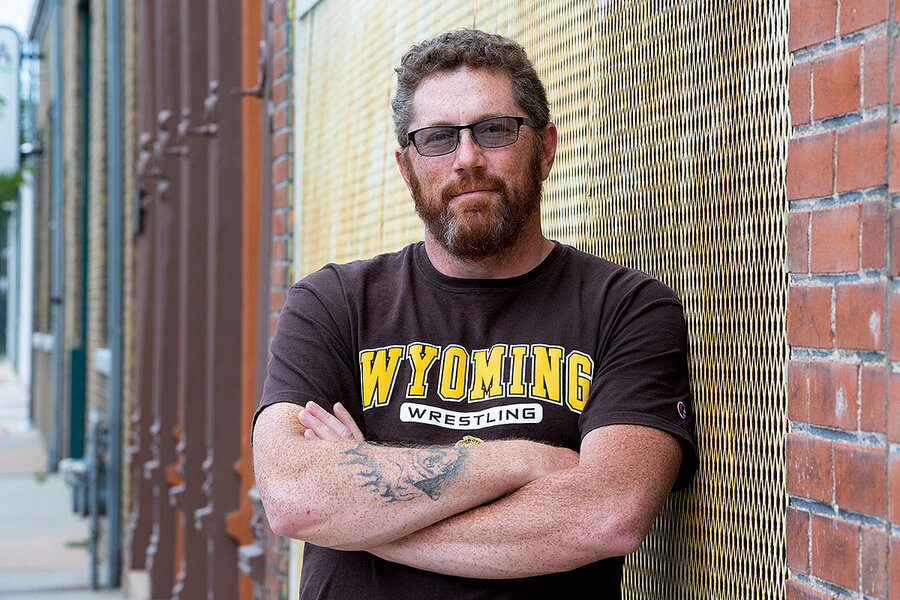
Melanie Stetson Freeman/StaffJesse Solaas worked as a miner for 10 years but now supervises a wind farm near Medicine Bow, Wyoming.
In many ways, Jesse Solaas illustrates those changes. A native of a small town in Wyoming, Mr. Solaas entered the mines after college and spent the next 10 years working underground in coal and hard rock mining. But a layoff, two young children, and dissatisfaction with local schools in the “big town” of Rock Springs prompted him to move back to Hanna (population 774). For work, he applied to be a technician on a nearby wind farm in 2005.
The only problem: He was afraid of heights. The first time he climbed a tower, “my stomach was in knots. I was wondering, ‘what did I just do?’” But he stuck with it, and after moving around several companies, he now supervises the wind farm where he started. On a ridge 400 feet above his office at the Ekola Flats wind farm near Medicine Bow, 69 turbines have been spinning for two decades, and are about to be replaced by 13 more efficient machines.
Mr. Solaas says he thrives on the technological change. “I like staying on my toes.” As he chats, his phone bugles with updates on lightning storms. If one gets within 30 miles, his workers climb down from the towers. He expects wind power will be a growing industry for his entire career. But he still hates heights.
“I’ve learned to listen,” he says of climbing a 285-foot turbine. “Instead of arguing with my body, I stay low, I don’t push it. I make sure my lanyard is tight. I think respecting it makes me safer.”
“There’s no perfect power”
Wind isn’t the only renewable energy here. On a sprawling cattle farm down a mostly dirt road near Glenrock, Wyoming, Stacey and Mark Schmid are assembling five long arrays of solar panels – 320 in all – on the prairie. The ranch sits at 7,200 feet. The sky is full of drama and rumbling clouds.
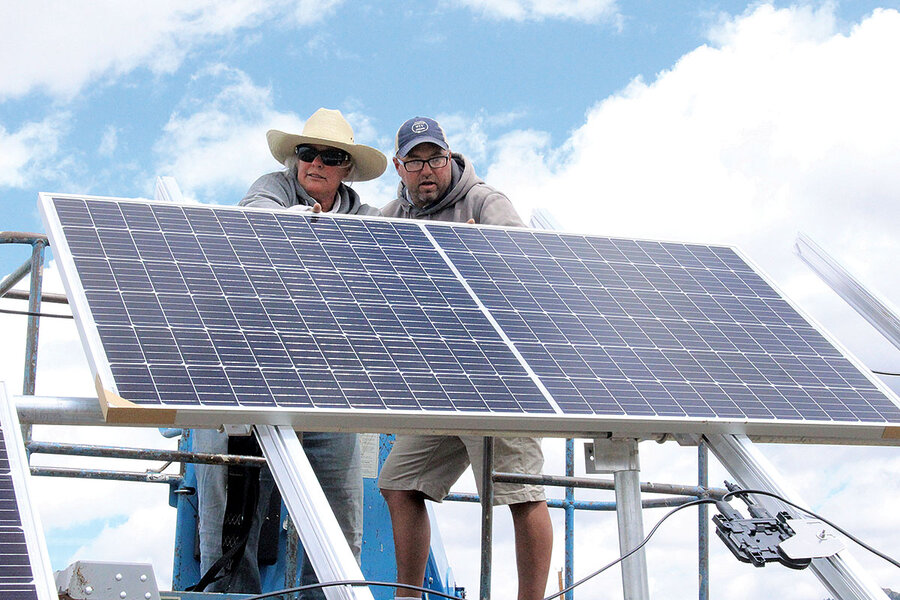
Doug Struck“It’s a battle,” says Stacey Schmid, who runs a solar company in Casper, Wyoming, with her husband, Mark. “Some people just don’t like solar. This is a fossil fuel state.”
The rancher, Billy Brenton, is eager to slash the $3,300-a-month electric bill he gets for the five homes, six barns, and farm equipment on his Echo Mountain Ranch, and he sees solar as the way to do it. “Ten years ago it wouldn’t have made sense, but now the technology has caught up,” says Mr. Brenton. When the solar array is operating, “I will basically have free power” with excess to sell back to the utility company.
The sun is not always an easy sell in Wyoming. The Schmids took over a small company, Range Solar and Wind, after they fled the movie industry in North Carolina in 2002 and bought vacant land west of Casper for a hog farm. Their business sold simple solar panels that cost $600 each. Since then, the industry has advanced dramatically. The array they are installing today is the size of a small generating station, and the couple routinely does $12,000 jobs on residential rooftops across the state.
“It’s a battle,” says Ms. Schmid. “Some people just don’t like solar. This is a fossil fuel state.”
But the changing energy scene is illustrated in the drive to the ranch. On the rolling prairie, bobbing pumps – “nodding donkeys” – slowly suck oil from underground. Down the road, 10 wind turbines sit perched on a ridge. On days when they are not spinning fast enough, a coal-fired generator at a local power plant kicks in, belching white steam, to produce electricity.
As she torques down a clamp on the solar array, Ms. Schmid thinks about the tableau around her and America’s energy future.
“We need them all,” she says, displaying a classic Western pragmatism. “There’s no perfect power.”
This story was produced with support from an Energy Foundation grant to cover the environment.
